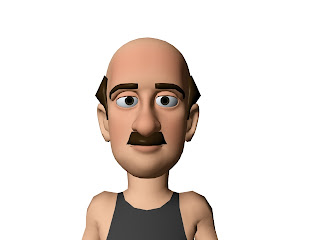PORTRAYING EMOTION:
i think the main reason referencing your animations is useful is because it helps the animator convey the feeling of emotion through either posing in pictures or even acting it out, if you don't reference your animation your technically blind animating (which is something i think I'm guilty of) and then you run the risk of your animation looking unrealistic and lifeless.
I went to the library at college and tried to find a few books that could help me when it came to expression, anticipation,emotion etc all the traits that make an animation look realistic, the books in the library were good, but most of them weren't really what i was looking for, however, i did come across an interesting book by Andy Wyatt called "The Complete Digital Animation Course-the principles,practice and techniques of successful digital animation" it pretty much covers everything from pre-production to post!
below are pages I've scanned from the book that i found interesting, to summarize its about how the animator must know the in's and out's of the character they are animating, it also talks about how one little movement can change the whole look of the pose/expression and gives examples, the book also indicates that to be a truly great animator you must know the basic theory of acting I've heard many animators discuss the similarities between acting and animating but never really took much notice until now! it's at this point in the blog that I'd like to point out how juvenile i have been and taken everything so laid back its taken me to 3rd year to realize the importance of literally learning everything i possibly can!
NORMAL EXPRESSION
Okay this is my normal expression, as you can see its pretty boring to say the least but talking of expression I'd say its pretty symmetrical, the corners of my mouth make a downward angle, and my upper eyelids are about halfway down my eyeball's my eyebrows are pretty much straight, a slight curve at the end but that's about it for this pose. SAD EXPRESSION
Okay for this one its mostly about the eyes and eyebrows, the mouth stays pretty much the same except maybe the corners of the mouth are again brought down slightly, but the eyebrows are going diagonally upwards from top to bottom and if you look at my eyelids carefully they follow the eyebrows.
HAPPY EXPRESSION
For the happy expression there is a lot of facial movement, firstly there are dimples but the rig i am using doesn't have dimples so we'll skip that one, nor does it have my horrible bags ha ha but yeah moving on, the eyebrows are pretty much straight except for maybe a soft curve, my eyes are really squinty and my cheeks are raised, the corners of my mouth are both up and my jaw is dropped slightly leaving my mouth open, notice that i am only showing my top teeth and my bottom lip is hiding the bottom teeth.
ANGRY EXPRESSION
SHOCKED EXPRESSION
Okay for this expression the face is long, the jaw is mostly open and the corners of the mouth are in slightly, the eyebrows are raised and the eyes are fully open.
CONFUSED EXPRESSION
Right as fun as these are, this is the final one, the confused expression which kinda looks like Im halfway through saying "whaaaat" my eyebrows are pulled in but low which brings my eyelids down causing me to wince, my lip on the right hand side is higher than the left which gives the top of my mouth a downwards diagonal shape my mouth is slightly open and my jaw is slightly lowered, again only showing my top teeth.
SCAN PAGES 441-445 OF THE ILLUSION OF LIFE
now as well as facial expressions posture is another great way to read what the character is feeling so that's what I'll be working on in this next part. this part can also be linked back to life drawing and just how vital it can be to capture the essence of the pose.
ANGRY POSE
The angry pose is something i believe is traditional, i remember as a kid seeing an angry person pose this way, clenched fists in front back leaning forward and a raised head, the key to this pose is to make the figure rigid and tense.
The angry pose is something i believe is traditional, i remember as a kid seeing an angry person pose this way, clenched fists in front back leaning forward and a raised head, the key to this pose is to make the figure rigid and tense.
RELAXED POSE
for the relaxed pose everything is pretty much just mid point, the shoulders are down the fingers are spaced out and loose the head is slightly raised almost like the neck can barely support the head the feet are quite well spread out, the back is pretty much straight except at the top it arch's slightly forward.
SAD POSE
This sad pose is something I would also consider traditional head down, arms hanging back, slouched forward, shoulders forward and feet closed in.
This sad pose is something I would also consider traditional head down, arms hanging back, slouched forward, shoulders forward and feet closed in.

























No comments:
Post a Comment